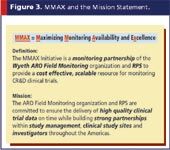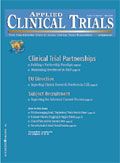Industry Partnerships: Changing the Way R&D Is Conducted
Applied Clinical Trials
Wyeth's positive experience with partnerships is a good example of R&D progress for the industry.
As we all know, our industry is under tremendous pressure to cut drug development time and costs while improving drug safety. At Wyeth, we recognized that the old ways of developing drugs had to change, and so our company has taken drastic steps to create new paradigms to remove cost and time from the development process. As development investments run roughly $1billion per new drug, we think there is plenty of opportunity for improvement.

Photography: Dynamic Graphics, Comstock, Eyewire Illustration: Paul A. Belci
Good science and execution
Wyeth's strategy takes on discovery and development in tandem with clinical research. As a result of our Clinical Breakthrough Program, Discovery and Clinical R&D now place one new compound into clinical development every month, which is a radical change from where we were 13 years ago— at perhaps three new compounds a year. The number of Wyeth investigational new drugs (INDs) filed per year is up significantly. The output in pharmacology is up an amazing 1000 percent, we have a 10-fold increase in output from Phase I, and there is a dramatic increase in Phase II and III trials.
With this rapid escalation in work, Wyeth needed to make major investments or find a significant breakthrough in our Clinical Data Management (CDM). We anticipated a phenomenal 50% increase in case report form (CRF) pages in a two-year period. We were already outsourcing a significant amount of our data entry work, and with this further increase in volume, we were convinced that our CDM system would require a major investment and change in processes in order to keep up.
We needed to refit the CDM model to handle more studies more effectively, to keep our project management control, and to ramp up the new technology that would be the backbone of the new model, all while maintaining quality throughout.
ACE
The solution was the Alliance for Clinical data Excellence (ACE). This joint venture brings together the best expertise of both Wyeth and Accenture, as shown in Figure 1. In it, we set up a CDM service unit, with CRF design and database responsibility, and also outsourced the transactional activities of clinical data entry and cleaning to a site offshore. The model utilizes our own experienced people for the theoretical underpinnings in CDM, study design, SOPs, validation, and regulated environments, and Accenture's expertise in project and operations management, training, information technology skills, and best practices—combining them in a way that can support both paper and electronic data.

Figure 1. ACE-a Dedicated Service Unit: A "merger" of the best of Accenture and Wyeth, working together to deliver guaranteed improvements with lower risk.
While most change-management experts advise changing one thing at a time, we changed everything nearly simultaneously. Fourteen capability teams, comprised of over 150 subject-matter experts, re-engineered the entire Wyeth clinical development process from end-to-end.
The proof is in the pudding
Wyeth's relationship with Accenture is a true partnership. The model has intrinsic performance and productivity commitments for both Wyeth and ACE (called Operating Level Agreements or OLAs for Wyeth, and Service Level Agreements or SLAs for ACE), and provides incentives for those deliverables. To meet these goals, set against a 2003 baseline, Wyeth and ACE will need to accomplish a number of key metrics three times faster by 2007. To achieve this acceleration, we set targets for a multitude of parameters, including:
- business days from approved protocol to approved proof book
- business days from CRF received to database ready for entry
- calendar days from last patient visit to database lock
- days from database lock to key statistics
Already, we are making tremendous progress in reaching the targets. ACE hired, trained, and certified 200 onshore employees and 400 employees in Bangalore, India, who, as they come online, will further accelerate the progress. Bear in mind that this transformation has all been done while continuing to do our ongoing work.
Quality metrics
Productivity, time, and cost progress cannot come at the expense of quality, so Wyeth re-engineered that part of the model. We made a deliberate effort to build-in performance measures around quality. Among the factors we evaluate are the number of audits lasting longer than 120 days, the trip report review workload, and the number of days per reviewer to complete the review. All of these measures have improved significantly due to the Clinical Breakthrough Program.
Additionally, in standard industry-wide comparisons, Wyeth has improved 20% to 40%, bringing us to the front of the pack in terms of performance, as shown in Figure 2. For a company the size of Wyeth to make such dramatic gains in a few years validates our breakthrough thinking.

Figure 2. Wyeth CR&D metrics.
Key success factors
Our success started with a strategic vision. We first needed to determine where we were headed as a business before we could answer key questions (e.g., how to in-source and outsource). For Wyeth CR&D, the future meant radically changing the way we managed data because we could see what was coming from R&D. The commitment we received from senior management, especially Dr. Robert Ruffolo, president, Wyeth R&D, and the governing structures of Wyeth was crucial to the success of the Clinical Breakthrough Program and the ACE partnership.
Although success requires metrics and performance management, it also requires relationship management, which hinges on trust. With this venture, we know that our partners will let us know early on—and vice-versa—about any issues so that we can adjust to meet our timelines, since both organizations participate freely in all study-related discussions.
In addition, by pushing the state-of-the-art in communication and IT, we can more readily work closely as partners. Wyeth conducts clinical studies in over 45 countries, with operations spanning the globe. With a strong IT infrastructure, we maintain a bimonthly meeting schedule that permits us to work very closely with our partners, staying up to date on the details of each study.
Lastly, at the end of 2004, both Wyeth and Accenture achieved their respective partnership goals. By doing things well (i.e., focusing on the issues, solving problems, working well together, and treating people right) we optimized value for both companies.
Moving on: MMAX
Now that we are well underway with ACE, we have examined our field monitoring organization. Similar to the old CDM, we had a mix of CROs and vendors that was very difficult to manage and that could be improved through realignment. To this end, in April 2005 we announced a second new groundbreaking alliance with ReSearch Pharmaceutical Services (RPS) called MMAX (Maximizing Monitoring Availability and Excellence).
MMAX is a field monitoring partnership between Wyeth's Americas Research Organization (ARO) and RPS to provide a cost-effective, therapeutically aligned, and scalable resource for monitoring needs (see Figure 3). Our mission is to provide high-quality field monitoring services while building partnerships within the management of study sites and with investigators in North and South America.

Figure 3. MMAX and the Mission Statement.
The MMAX objective is one of strategic outsourcing versus gap filling. As with ACE, the partnership is going to have penalties and bonuses built-in. MMAX should be transparent and seamless. The governance structure includes performance accountability, common measurements of successes, and challenges for both partners. MMAX will decrease our dependency on outsourcing and on CROs for field monitoring, both saving money and increasing quality and flexibility. Together with RPS, we are planning for a win–win partnership, just like ACE has been. And we expect to get increased quality as well. This is not just about cost avoidance. It's about fundamentally changing the model for field monitoring.
Wyeth is about fundamentally changing the way R&D is conducted to drive down both time and cost in developing new, innovative treatments that improve the lives of patients. It is reflected in our mission statement, "Leading the Way to a Healthier World," because it is imperative to the future of the industry and Wyeth's role in the future of the pharmaceutical industry. ACE and MMAX are only two of a series of upcoming change initiatives in clinical R&D. Stay tuned for more changes in the years to come.
Note: This article is based on a presentation at the Annual CRO Partnerships Conference, April 4, 2005.
Ira Spector is vice president, clinical development operations, with Wyeth Research, 500 Arcola Road, Collegeville, PA 19426.

Improving Relationships and Diversifying the Site Selection Process
April 17th 2025In this episode of the Applied Clinical Trials Podcast, Liz Beatty, co-founder and chief strategy officer, Inato, discusses a number of topics around site engagement including community-based sites, the role of technology in improving site/sponsor relationships, how increased operational costs are impacting the industry, and more.